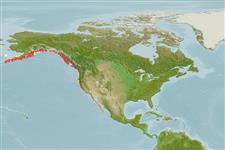Common names from other countries
Environment: milieu / climate zone / depth range / distribution range
Ecologia
; intervalo de profundidade 0 - 55 m (Ref. 95344). Temperate, preferred 5°C (Ref. 107945); 61°N - 35°N, 169°W - 120°W
Eastern Pacific: Alaska, Canada and USA. From Aleutian Islands to Pismo Beach, California.
Length at first maturity / Tamanho / Peso / Idade
Maturity: Lm ?, range 9 - 11.75 cm Max length : 18.0 cm SHL macho/indeterminado; (Ref. 95344); Idade máx. registada: 19 anos (Ref. 126990)
Typically found along the intertidal zone on surf-exposed beaches with siphon shows exposed on the substrate (Ref. 95344).
Life cycle and mating behavior
Maturidade | Reprodução | Desova | Ovos | Fecundidade | Larvas
Members of the class Bivalvia are mostly gonochoric, some are protandric hermaphrodites. Life cycle: Embryos develop into free-swimming trocophore larvae, succeeded by the bivalve veliger, resembling a miniature clam.
Lassuy, D.R. 1989. (Ref. 78181)
Status na Lista Vermelha da IUCN (Ref. 130435)
Status no CITES (Ref. 108899)
Not Evaluated
Not Evaluated
Uso pelos humanos
Pescarias: espécies comerciais
FAO - pescarias: landings | FishSource | Sea Around Us
Ferramentas
Fontes da internet
Estimates based on models
Preferred temperature
(Ref.
115969): 5.6 - 12.6, mean 8.9 (based on 118 cells).
Resiliência
Elevada, tempo mínimo de duplicação da população menor que 15 meses (K=0.59; tm=2; tmax=19).
